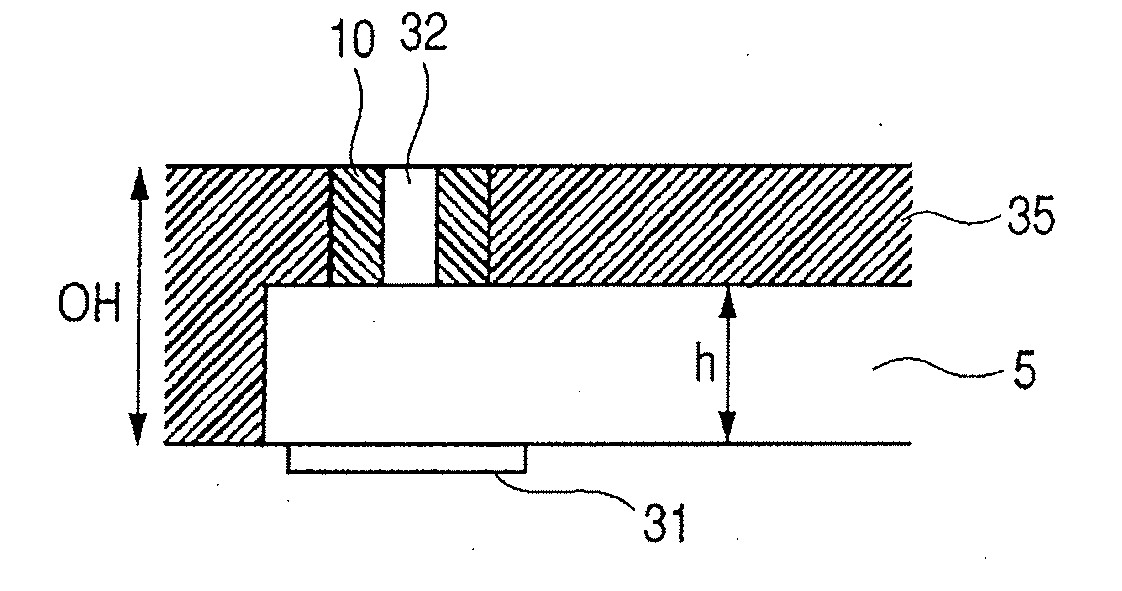Liquid discharge method, liquid discharge head and liquid discharge apparatus
a liquid discharge head and liquid discharge technology, applied in printing and other directions, can solve the problems of increasing the quantity of liquid discharged by the inertial force, affecting the image quality, etc., and achieve the effect of reducing satellites and mists
- Summary
- Abstract
- Description
- Claims
- Application Information
AI Technical Summary
Benefits of technology
Problems solved by technology
Method used
Image
Examples
embodiment 2
Comparison Example 2
[0094] In Table 2, results obtained under the same conditions as in embodiment 1 described above are shown, except for the structure (the diameter of a discharge port, flow paths, an OH distance and projection shapes) of a head. Embodiment 2-1 is an example wherein projections are inserted between semi-circular portions of a diameter of 11 μm, as shown in FIG. 17, and the relationship between M, L and H and the values in the table is the same as that for embodiment 1. In this embodiment, x2 / x1=1.35 and x1≧x2, and the discharge quantity is 1.7 ng. Comparison example 2 employs a circular discharge port of a diameter of 11 μm, and the discharge quantity is 1.5 ng. According to the head having projections in this embodiment, the liquid separation time was advanced, compared with the circular one in comparison example. Further, it could be confirmed that the discharged liquid droplet was shortened, and the number of satellites was reduced. Additionally, the number of...
embodiment 3
Comparison Example 3
[0095] In Table 3, results obtained under the same conditions as in embodiment 2 described above are shown, except for the structure (the diameter of a discharge port, flow paths, an OH distance and projection shapes) of a head.
[0096] Embodiments 3-1 to 3-5 are examples wherein projections of sizes written in the table are inserted between semi-circular portions of a diameter of 11 μm, as shown in FIG. 17, and the relationship between M, L and H and the values in the table is the same as that for embodiment 1. In these embodiments, the discharge quantity is 1.7 ng. In the range of 1.6≧x2 / x1, as shown in embodiments 3-1 to 3-5, a small number of satellites was obtained as a result. Comparison example 3-1 employs a circular discharge port having a diameter of 11 μm, and the discharge quantity is 1.6 ng. Comparison example 3-2 employs the shape wherein projections of a length 0.7 are inserted between semi-circular portions of a diameter of 11 μm, and the discharge...
embodiment 4
Comparison Example 4
[0097] In Table 4, results obtained under the same conditions as in embodiment 3 described above are shown, except in that the diameter of a discharge port was increased more.
[0098] Embodiment 4 is an example wherein projections of sizes written in the table are inserted between semi-circular portions of a diameter of 13 μm, as shown in FIG. 17, and the relationship between M, L and H and the values in the table is the same as that for embodiment 1. In this embodiment, x2 / x1=0.8 and x1≧x2. The discharge quantity is 2.3 ng. Comparison example 4 employs a circular discharge port having a diameter of 13 μm and the discharge quantity is 2.3 ng. According to this, for the head in this embodiment that has projections, it was confirmed that, compared with the circular one in the comparison example, the liquid separation time was advanced, the discharged liquid droplet was shortened and the satellites were reduced. The number of particles changed as a mist was also sha...
PUM
 Login to View More
Login to View More Abstract
Description
Claims
Application Information
 Login to View More
Login to View More - R&D
- Intellectual Property
- Life Sciences
- Materials
- Tech Scout
- Unparalleled Data Quality
- Higher Quality Content
- 60% Fewer Hallucinations
Browse by: Latest US Patents, China's latest patents, Technical Efficacy Thesaurus, Application Domain, Technology Topic, Popular Technical Reports.
© 2025 PatSnap. All rights reserved.Legal|Privacy policy|Modern Slavery Act Transparency Statement|Sitemap|About US| Contact US: help@patsnap.com



